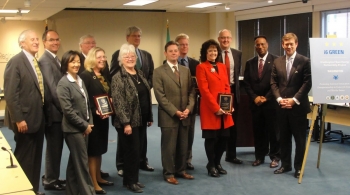Guest blog post by Matthew S. Erskine, U.S. Deputy Assistant Secretary of Commerce for Economic Development
The Seattle region is noted as one of our nation’s hotbed of innovation and entrepreneurship with world-class cleantech, health sciences, biotechnology and advanced manufacturing clusters. It is home to the headquarters of companies like Microsoft, Amazon and Starbucks and its regional assets are fueling job growth.
This week, I traveled to Seattle to spotlight Obama administration investments to advance these critical innovation clusters, promote entrepreneurship and small business development and create the jobs and industries of the future.
I met with the leaders of the Washington Clean Energy Partnership, awardees of the i6 Green competition. This collaboration between the Puget Sound Regional Council, South Seattle Community College, Cleantech Open and the Innovate Washington Foundation will work to foster collaboration between industry and institutions of higher education to expand the clean energy cluster. This will spur the creation of new jobs, companies and export opportunities in the market for energy efficient technologies.
I toured the facilities of enterpriseSeattle, a partnership charged with building a competitive, world-class economy in King County and its 39 cities. enterpriseSeattle is one of the winners of the Obama administration’s Jobs and Innovation Accelerator Challenge. They are using the federal funding to initiate the Washington Interactive Media Accelerator (WIMA) project to advance western Washington State and the Puget Sound region’s interactive media industry. While the industry has proven to be extremely entrepreneurial, there is little infrastructure or support services to assist new startups, to provide internships and other professional training opportunities, to collaborate on improved curriculum development and mentoring, or to provide both a common physical space and a virtual portal that will foster and maintain new businesses and potential employees. The WIMA will bring together industry, education, and economic development leaders to collaborate and find solutions to this challenge.
This is critical work. The United States cannot afford to sit on the sidelines while other nations capitalize on high-growth sectors. Key to national competitiveness is regional competitiveness. If America’s regions are strong, America will be strong.
Agencies across the administration are making investments to foster collaboration and advance the capacity of regions to address complex issues and leverage their unique assets.
A U.S. Commerce Department Economic Development Administration (EDA) investment in the region’s biomedical cluster is helping the Seattle Biomedical Research Institute purchase and install innovative technologies to enable the scientific research process. At South Seattle Community College, I saw how EDA funds are being used to establish a workforce training facility and provide critical equipment are helping to support clean technology advanced manufacturing. And in Renton, just outside of Seattle, I toured a former Boeing Company aircraft manufacturing site that EDA helped to redevelop. This site is now populated by companies like Distant Lands Coffee, which uses a vertically integrated advanced manufacturing process to produce its product.
As other countries begin to challenge American leadership in innovation, America must expand its ability to transfer science and engineering breakthroughs from the laboratory to the commercial marketplace. The Seattle region is a great example of how the Obama administration is investing at home to increase our competitiveness abroad. That is good news for America’s economy and workers.



Comments Closed
Due to increased spam, comments have been closed on this content. If you wish to comment about the content, we encourage you to email webmaster@doc.gov.